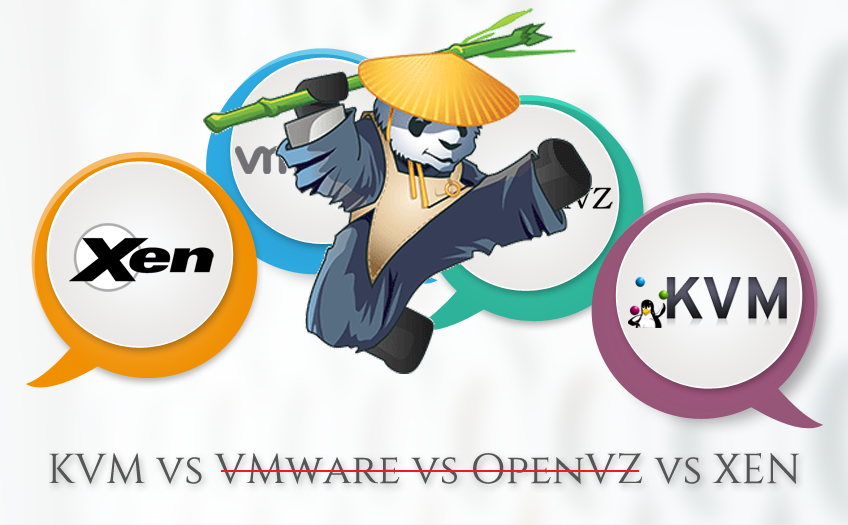Performance Indicators: KVM vs. Xen
We at Cloud4Y consider VmWare products as the leading virtualization solution. However, we are interested in other solutions, including Xen and KVM. And here's what we noticed: there is not too much information to compare these hypervisors: the last good research that we found on the network relates to 2012 and, of course, can no longer be considered relevant. Today we will present to your attention not the newest, but, in our opinion, quite a useful study on the performance of KVM and Xen hypervisors.

KVM hypervisor
Forgive us virtualization gurus, but first we remind readers what a hypervisor is and what it is for. To perform various tasks (software development, hosting
KVM is software that allows virtualization based on a PC running Linux and similar. Recently, KVM is considered a component of the
During operation, KVM accesses the kernel directly through a

Xen hypervisor
Initially, Cambridge students launched a project that eventually became a commercial version of Xen. The first release is dated 2003, and in 2007 Citrix bought the source code. Xen is a cross-platform hypervisor with great functionality and enormous capabilities, which makes it possible to use it in the corporate sphere. Xen supports paravirtualization — a special operating system kernel mode when the kernel is configured to work simultaneously with the hypervisor.
The Xen code added only the necessary set of functions: management of virtual memory and processor clock frequency, work with DMA, real-time timer and interrupts. The rest of the functionality is rendered to the domains, that is, to the virtual machines running at that time. Thus, Xen is the easiest hypervisor.
')
The essence of the study
Testing is based on the use of two SuperMicro servers, each with a quad-core Intel Xeon
For hosting and virtual machines we took Fedora 20 (with SELinux). Here are the software versions we took:
- Kernel: 3.14.8
- For KVM:
qemu-kvm 1.6.2 - For Xen: xen 4.3.2
All root file systems are XFS with the default configuration. Virtual machines are created using
Explanations
In addition, the competition between hypervisors is tightly controlled and minimized. On most virtual servers, you will have several virtual machines competing for processor time, I / O devices, and network access. Our testing does not take this into account. One hypervisor may have low performance with low competition for resources, and then show far more efficiency than competitors when the fight for resources is higher.
The study was conducted on Intel processors, so its results may differ for AMD and ARM.
results
Tests for virtual machines installed directly on hardware, that is, without an operating system (hereinafter referred to as hardware), served as the basis for testing virtual machines. The performance penalty between the two servers without virtualization was 0.51% or less.
KVM performance fell within 1.5% compared to the “iron” in almost all tests. Only two tests showed a different result: one of them was the
In the PostMark test, the Xen was 14.41% slower than the hardware. At restart, the test results differed from the initial by 2%. The best test for KVM, MAFFT, turned out to be the second worst in the list for Xen.
Here is a brief summary of the test:
| Best Value | Bare metal | KVM | Xen | |
|---|---|---|---|---|
| Timed MAFFT Alignment | lower | 7.78 | 7.795 | 8.42 |
| Smallpt | lower | 160 | 162 | 167.5 |
| Pov ray | lower | 230.02 | 232.44 | 235.89 |
| Postmark | higher | 3667 | 3824 | 3205 |
| Openssl | higher | 397.68 | 393.95 | 388.25 |
| John the Ripper (MD5) | higher | 49548 | 48899.5 | 46653.5 |
| John the Ripper (DES) | higher | 7374833.5 | 7271833.5 | 6911167 |
| John the Ripper (Blowfish) | higher | 3026 | 2991.5 | 2856 |
| CLOMP | higher | 3.3 | 3.285 | 3.125 |
| C-ray | lower | 35.35 | 35.66 | 36.13 |
| 7-zip | higher | 12467.5 | 12129.5 | 11879 |
If you want to see the results in full, follow the link .
Instead of conclusion
In our testing, KVM was almost always 2% slower than hardware. Xen was 2.5% slower in three tests out of ten, and the rest even worse: 5-7%. Although KVM showed itself best in the PostMark test, it should be noted that we performed only one I / O test, and it is worthwhile to conduct a few more for a more reliable picture.
To select the right hypervisor, you need to correctly assess the nature of your workloads. If your workloads require less CPU power and more I / O, then you can run more I / O tests. If you work mostly with audio and video, try x264 or mp3 tests.
[UPD] As mister_fog rightly noted, in 2007, Citrix bought not Xen source code, but XenSource, which was founded by Xen developers and was engaged in the commercial development of this open source project. Proof
Source: https://habr.com/ru/post/282918/
All Articles